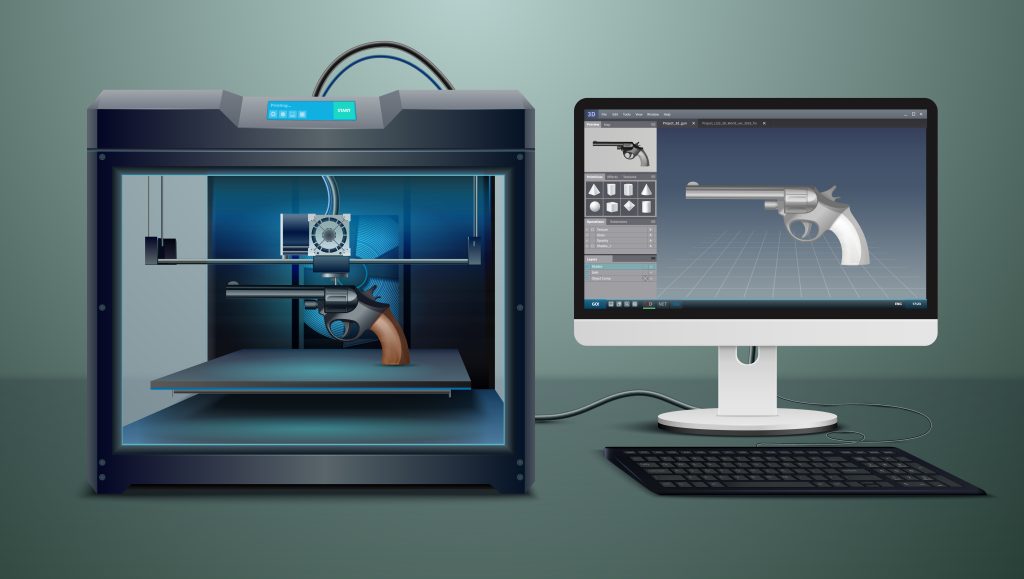Are you curious about 3D-printed guns and their legality? This complex issue is constantly evolving. With the advancement of 3D printing technology, concerns have arisen regarding the safety and legality of these firearms. Federal laws in the United States govern the manufacture, distribution, and sale of firearms, including those made through 3D printing. While making a gun with a 3D printer is generally legal, some states have implemented their own regulations to restrict homemade guns. Sharing blueprints online also raises contentious debates. Understanding the current restrictions and complying with laws are crucial to avoid legal consequences. Additionally, safety considerations must be taken into account during manufacturing to ensure these guns are safe.
The Basics of 3D-Printed Guns
3D-printed guns are firearms that can be manufactured using a 3D printer, and in most cases, it’s legal for you to make one as federal law permits the unlicensed manufacture of firearms. These guns are made using various materials suitable for 3D printing, such as plastic polymers or even metal alloys. DIY gun manufacturing has become possible due to advancements in 3D printing technology.
When it comes to the components of 3D-printed guns, they can vary depending on the design and model. Some blueprints focus on the lower receiver, which is the part responsible for housing important firearm mechanisms. This component often requires a federal background check if purchased separately from licensed dealers. However, many people choose to print these lower receivers at home and combine them with other commercially available parts that do not require background checks.
It’s important to note that firearm regulations still apply to 3D-printed guns. While federal law allows their unlicensed manufacture, some states have implemented additional restrictions on homemade firearms. It is crucial to familiarize yourself with your state’s specific laws regarding DIY gun manufacturing before attempting to create a 3D-printed gun.
Lastly, ensuring safety when working with 3D-printed guns is essential. Due to variations in materials and manufacturing techniques, it’s crucial to follow proper guidelines and quality control measures during production. Understanding how different materials behave under stress and testing the durability of printed components are vital steps towards maintaining safe usage of 3D-printed firearms.
Understanding the Legalities of 3D-Printed Guns
Understanding the current legalities surrounding these firearms can be complex and requires careful research. Age restrictions, licensing requirements, international regulations, traceability concerns, and law enforcement perspectives are all factors that come into play when discussing the legality of 3D-printed guns.
Age restrictions vary from country to country and even within different states or regions. It is crucial to familiarize yourself with the specific laws in your jurisdiction regarding the minimum age for owning or possessing a firearm.
Licensing requirements also differ depending on where you are located. Some countries may require individuals to obtain a license or permit before manufacturing or owning a 3D-printed gun. It is important to consult local authorities or legal experts to understand the specific licensing procedures and requirements in your area.
International regulations play a significant role in determining the legality of 3D-printed guns. The export and import of defense-related articles are governed by organizations like ITAR (International Traffic in Arms Regulations) and regional directives such as the European Firearms Directive.
Traceability concerns arise due to the nature of 3D-printed guns being untraceable by traditional means. This raises issues related to crime prevention, law enforcement investigations, and national security.
Law enforcement perspectives on 3D-printed guns tend to focus on their potential misuse and evasion of metal detectors. There are concerns about these firearms being used for illegal activities or being brought into prohibited areas without detection.
To ensure compliance with existing laws and regulations, it is essential to conduct comprehensive research, consult legal professionals, and stay updated on any changes in legislation regarding age restrictions, licensing requirements, international regulations, traceability concerns, and law enforcement perspectives related to 3D-printed guns.
Regulations on the Manufacturing and Distribution of 3D-Printed Guns
When it comes to regulations on manufacturing and distributing these firearms, you need to be aware of the specific laws in your jurisdiction. Age restrictions, licensing requirements, federal regulations, state regulations, and international regulations all play a role in determining the legality of 3D-printed guns.
In terms of age restrictions, many countries have laws that prohibit individuals under a certain age from owning or accessing firearms. Licensing requirements also vary by jurisdiction, with some places requiring individuals to obtain a license before manufacturing or distributing 3D-printed guns.
At the federal level, different countries have their own set of regulations governing firearms. For example, the United States has the Gun Control Act which regulates the manufacture, distribution, and sale of firearms. Additionally, international regulations such as the International Traffic in Arms Regulations (ITAR) control the export and import of defense-related articles.
State regulations within a country can further restrict or regulate 3D-printed guns. Some states may require additional licenses or impose stricter guidelines for manufacturing and distribution.
It is important to note that these laws and regulations are constantly evolving as technology advances and new challenges arise. Therefore, it is crucial to stay informed about any updates or changes in your jurisdiction’s laws regarding 3D-printed guns.
Concerns and Controversies Surrounding 3D-Printed Guns
If you’re considering the use of this technology, it’s important to be aware of the concerns and controversies surrounding these firearms. 3D-printed guns have raised significant safety implications, particularly in relation to law enforcement concerns. One major concern is the lack of traceability that these guns possess. Due to their nature of being made outside traditional supply chains and not requiring background checks, they are effectively invisible to law enforcement agencies. This lack of traceability raises worries about their potential use in crimes.
Additionally, there are concerns about the ability of fully 3D-printed guns to evade metal detectors and be brought into prohibited areas. While these concerns may currently be largely unfounded since 3D-printed gun designers have yet to develop alternative metal bullets, the lack of traceability has attracted the interest of terrorist groups. Terrorist organizations see the potential for having workable, usable, and efficient 3D-printed weapons.
Overall, while ownership and manufacturing of 3D-printed guns may be legal in some countries, it is crucial to consider the safety implications and potential for crime associated with these firearms. Law enforcement agencies continue to monitor this issue closely due to its evolving nature and ongoing technological advancements.
Navigating the Complexities of 3D-Printed Gun Laws
Navigating the complexities of 3D-printed gun laws can be challenging due to the evolving nature of regulations and varying restrictions in different countries. When it comes to 3D printed gun safety, understanding international regulations is crucial. Each country has its own set of legal implications surrounding the manufacturing and distribution of these firearms. Additionally, age restrictions and licensing requirements may apply.
It is important to note that while owning a 3D-printed gun may be legal in many countries, there are still concerns about their safety and traceability. The lack of regulation and ability for these guns to evade metal detectors raises valid concerns for law enforcement agencies.
In terms of legality, federal laws in the United States permit the unlicensed manufacture of firearms using a 3D printer. However, some states have implemented their own regulations that restrict homemade guns or require additional steps such as obtaining a serial number or federal manufacturing license.
Furthermore, the online sharing of 3D-printed gun blueprints remains unclear in terms of legality. While no federal legislation explicitly bans this practice, previous rulings have deemed releasing blueprints online as a violation of arms export laws.
To navigate these complexities effectively, it is advisable to consult with legal professionals who can provide guidance on specific jurisdictional requirements and ensure compliance with applicable laws and regulations regarding 3D-printed guns.



